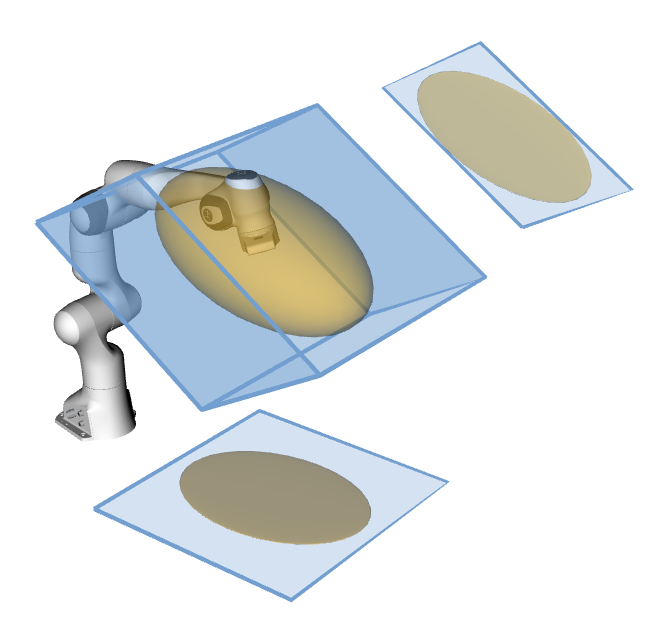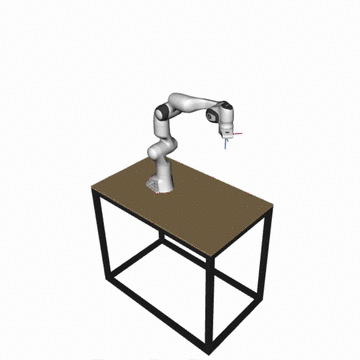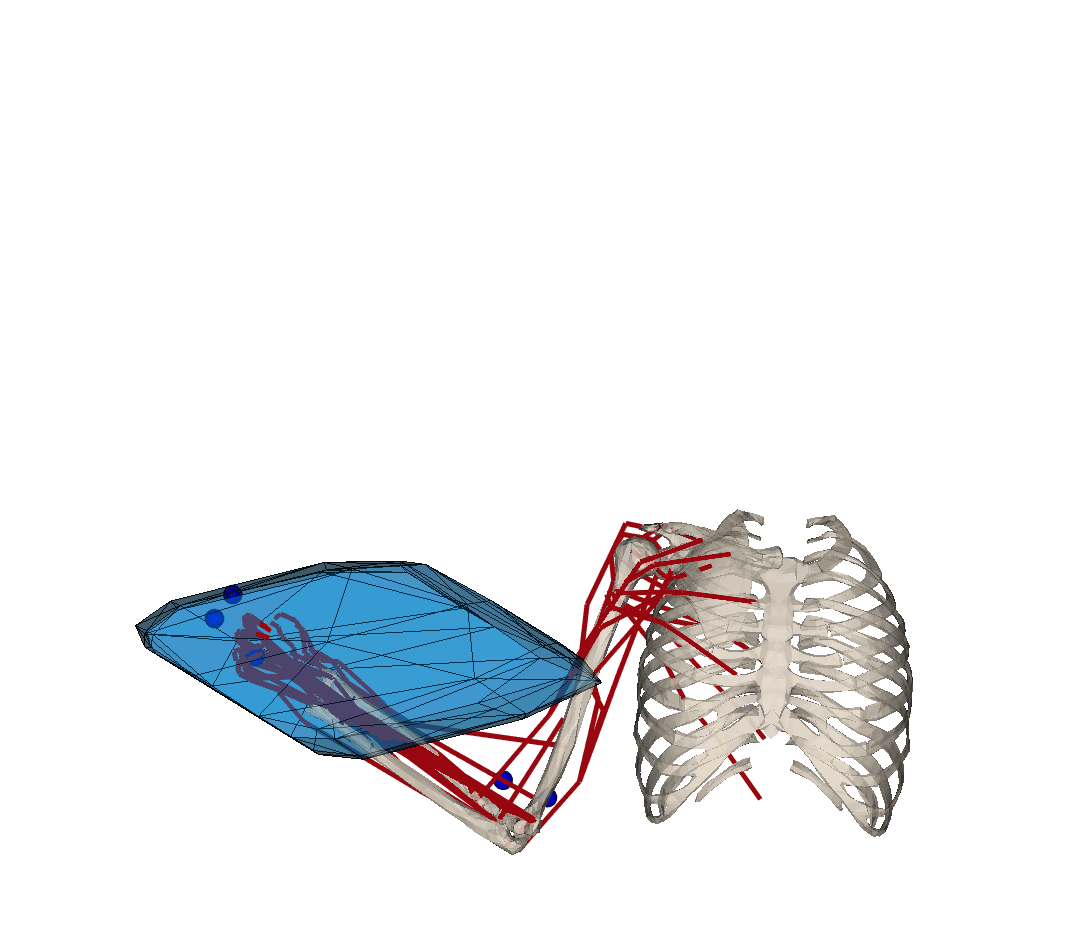A real-time task space capacity calculation module for robotic manipulators and human musculoskeletal models
Project description
Real-time capable task-space capacity calculation python pip package
The pycapacity package provides a framework for the generic task-space capacity calculation for:
- Robotic serial manipulators -
pycapacity.robot - Human musculoskeletal models -
pycapacity.human
This package also provides a module pycapacity.algorithms with a set of polytope evaluation algorithms for standard polytope formulations, that can be used as a standalone library.
Additionally, pycapacity.visual module provides a set of visualisaiton tools using the matplotlib for visualising 2d and 3d polytopes.
See full API documentation and docs.
Robotic manipulator capacity metrics

For the robotic manipulators the package integrates several velocity, force and acceleration capacity calculation functions based on ellipsoids:
- Velocity (manipulability) ellipsoid
E_vel = {dx | dx = J.dq, ||dq||<1 } - Acceleration (dynamic manipulability) ellipsoid
E_acc = {ddx | ddx = J.M^(-1).t, ||t||<1 } - Force ellipsoid
E_for = {f | J^T.f = t, ||t||<1 }
And polytopes:
- Velocity polytope
P_vel = {dx | dx = J.dq, dq_min < dq < dq_max} - Acceleration polytope
P_acc = {ddx | ddx = J.M^(-1).t, t_min < t < t_max} - Force polytope
P_for = {f | J^T.f = t, t_min < t < t_max} - Force polytopes Minkowski sum and intersection
Where J is the robot jacobian matrix, f is the vector of cartesian forces,dx and ddx are vectors fo cartesian velocities and accretions, dq is the vector of the joint velocities and t is the vector of joint torques.
The force polytope functions have been implemented according to the paper:
On-line force capability evaluation based on efficient polytope vertex search
by A.Skuric, V.Padois and D.Daney
Published on ICRA2021
And the velocity and acceleration polytopes are resolved using the Hyper-plane shifting method:
Characterization of Parallel Manipulator Available Wrench Set Facets
by Gouttefarde M., Krut S.
In: Lenarcic J., Stanisic M. (eds) Advances in Robot Kinematics: Motion in Man and Machine. Springer, Dordrecht (2010)
Human musculoskeletal models capacity metrics

For the human musculoskeletal models this package implements the polytope metrics:
- Velocity polytope
P_vel = {dx | dx = J.dq, dl = L.dq dl_min < dl < dl_max} - Acceleration polytope
P_acc = {ddx | ddx = J.M^(-1).N.F, F_min < F < F_max} - Force polytope
P_for = {f | J^T.f = N.F, F_min < F < F_max}
Where J is the model's jacobian matrix, L si the muscle length jacobian matrix, N= -L^T is the moment arm matrix, f is the vector of cartesian forces,dx and ddx are vectors fo cartesian velocities and accretions, dq is the vector of the joint velocities, t is the vector of joint torques, dl is the vector of the muscle stretching velocities and F is the vector of muscular forces.
The force and velocity polytope functions have been implemented according to the paper:
On-line feasible wrench polytope evaluation based on human musculoskeletal models: an iterative convex hull method
by A.Skuric, V.Padois, N.Rezzoug and D.Daney
Submitted to RAL & ICRA2022
And the acceleration polytopes are resolved using the Hyper-plane shifting method:
Characterization of Parallel Manipulator Available Wrench Set Facets
by Gouttefarde M., Krut S.
In: Lenarcic J., Stanisic M. (eds) Advances in Robot Kinematics: Motion in Man and Machine. Springer, Dordrecht (2010)
Polytope evaluation algorithms
There are three methods implemented in this paper to resolve all the polytope calculations:
- Hyper-plane shifting method
- Iterative convex hull method
- Vertex enumeration auctus
All of the methods are implemented in the module pycapacity.algorithms and can be used as standalone functions. See in docs for more info.
Hyper-plane shifting method
Characterization of Parallel Manipulator Available Wrench Set Facets
by Gouttefarde M., Krut S.
In: Lenarcic J., Stanisic M. (eds) Advances in Robot Kinematics: Motion in Man and Machine. Springer, Dordrecht (2010)
This method finds the half-space representation of the polytope of a class:
P = {x | x = By, y_min <= y <= y_max }
To find the vertices of the polytope after finding the half-space representation Hx <= d an convex-hull algorithm is used.
The method is a part of the pycapacity.algorithms module hyper_plane_shift_method, See in docs for more info.
Iterative convex-hull method
On-line feasible wrench polytope evaluation based on human musculoskeletal models: an iterative convex hull method
by A.Skuric, V.Padois, N.Rezzoug and D.Daney
Submitted to RAL & ICRA2022
This method finds both vertex and half-space representation of the class of polytopes:
P = {x | Ax = By, y_min <= y <= y_max }
And it can be additionally extended to the case where there is an additional projection matrix P making a class of problems:
P = {x | x= Pz, Az = By, y_min <= y <= y_max }
The method is a part of the pycapacity.algorithms module iterative_convex_hull_method. See the docs for more info
Vertex enumeration auctus
On-line force capability evaluation based on efficient polytope vertex search
by A.Skuric, V.Padois and D.Daney
Published on ICRA2021
This method finds vertex representation of the class of polytopes:
P = {x | Ax = y, y_min <= y <= y_max }
To find the half-space representation (faces) of the polytope after finding the vertex representation an convex-hull algorithm is used.
The method is a part of the pycapacity.algorithms module vertex_enumeration_auctus. See the docs for more info
Installation
All you need to do to install it is:
pip install pycapacity
And include it to your python project
import pycapacity.robot
# and/or
import pycapacity.human
#and/or
import pycapacity.algorithms
#and/or
import pycapacity.visual
Other way to install the code is by installing it directly from the git repo:
pip install git+https://gitlab.inria.fr/auctus-team/people/antunskuric/pycapacity/
Package API docs
See full docs at the link
Modules
Functions
Robot metrics
robot.acceleration_ellipsoid: acceleration ellipsoid calculation (dynamic manipulability ellipsoid)robot.acceleration_polytope: Acceleration polytope calculating functionrobot.acceleration_polytope_withfaces: Acceleration polytope calculating functionrobot.force_ellipsoid: force manipulability ellipsoid calculationrobot.force_polytope: Force polytope representing the capacities of the two robots in a certain configurationrobot.force_polytope_intersection: Force polytope representing the intersection of the capacities of the two robots in certain configurations.robot.force_polytope_intersection_withfaces: Force polytope representing the intersection of the capacities of the two robots in certain configurations.robot.force_polytope_sum_withfaces: Force polytope representing the minkowski sum of the capacities of the two robots in certain configurations.robot.force_polytope_withfaces: Force polytope representing the capacities of the two robots in a certain configuration.robot.velocity_ellipsoid: velocity manipulability ellipsoid calculationrobot.velocity_polytope: Velocity polytope calculating functionrobot.velocity_polytope_withfaces: Velocity polytope calculating function, with faces
Human metrics
human.acceleration_polytope: A function calculating the polytopes of achievable accelerationshuman.force_polytope: A function calculating the polytopes of achievable foreces basedhuman.joint_torques_polytope: A function calculating the polytopes of achievable joint torqueshuman.torque_to_muscle_force: A function calculating muscle forces needed to create the joint torques tauhuman.velocity_polytope: A function calculating the polytopes of achievable velocity based
Algorithms
algorithms.hyper_plane_shift_method: Hyper plane shifting method implementation used to solve problems of a form:algorithms.iterative_convex_hull_method: A function calculating the polytopes of achievable x for equations form:algorithms.vertex_enumeration_auctus: Efficient vertex enumeration algorithm for a problem of a form:
Visualisation tools
visual.plot_polytope_faces: Polytope faces plotting function in 2d and 3dvisual.plot_polytope_vertex: Polytope vertices plotting function in 2d and 3d
Code examples
See demo_notebook.ipynb for more examples of how ot use the module.
Randomised serial robot example
"""
A simple example program for 3d force polytope
evaluation of a randomised 6dof robot
"""
import pycapacity.robot as capacity # robot capacity module
import numpy as np
m = 3 # 3d forces
n = 6 # robot dof
J = np.array(np.random.rand(m,n)) # random jacobian matrix
t_max = np.ones(n) # joint torque limits max and min
t_min = -np.ones(n)
vertices, face_indexes = capacity.force_polytope_withfaces(J,t_min, t_max) # calculate the polytope vertices and faces
faces = capacity.face_index_to_vertex(vertices, face_indexes)
print(vertices) # display the vertices
# plotting the polytope
import matplotlib.pyplot as plt
from pycapacity.visual import plot_polytope_faces, plot_polytope_vertex # pycapacity visualisation tools
fig = plt.figure(4)
# draw faces and vertices
ax = plot_polytope_vertex(plt=plt, vertex=vertices, label='force',color='blue')
plot_polytope_faces(ax=ax, faces=faces, face_color='blue', edge_color='blue', alpha=0.2)
plt.tight_layout()
plt.legend()
plt.show()
Randomised muslucoskeletal model example
"""
A simple example program for 3d force polytope
evaluation of a randomised 30 muscle 7dof
human musculoskeletal model
"""
import pycapacity.human as capacity # robot capacity module
import numpy as np
L = 30 # number of muscles
m = 3 # 3d forces
n = 6 # number of joints - dof
J = np.array(np.random.rand(m,n))*2-1 # random jacobian matrix
N = np.array(np.random.rand(n,L))*2-1 # random moment arm matrix
F_max = 100*np.ones(L) # muscle forces limits max and min
F_min = np.zeros(L)
vertices, H,d, face_indexes = capacity.force_polytope(J,N, F_min, F_max, 0.1) # calculate the polytope vertices and faces
faces = capacity.face_index_to_vertex(vertices, face_indexes)
print(vertices) # display the vertices
# plotting the polytope
import matplotlib.pyplot as plt
from pycapacity.visual import plot_polytope_faces, plot_polytope_vertex # pycapacity visualisation tools
fig = plt.figure(4)
# draw faces and vertices
ax = plot_polytope_vertex(plt=plt, vertex=vertices, label='force',color='blue')
plot_polytope_faces(ax=ax, faces=faces, face_color='blue', edge_color='blue', alpha=0.2)
plt.tight_layout()
plt.legend()
plt.show()
Project details
Release history Release notifications | RSS feed
Download files
Download the file for your platform. If you're not sure which to choose, learn more about installing packages.
Source Distribution
Built Distribution
Hashes for pycapacity-1.2.17-py3-none-any.whl
| Algorithm | Hash digest | |
|---|---|---|
| SHA256 | 2df87bb29dc1b0737a68608212b2baa0c60a9b454a618124ba2b205905aef86f |
|
| MD5 | 76354985c4e4f8b821ddd356251081b9 |
|
| BLAKE2b-256 | 91649f3a6b4d544550a2ca7dbd5c469999a701333add37591cf514037b8c0c43 |














